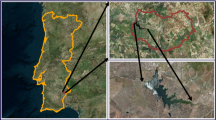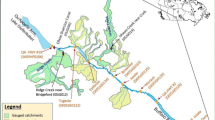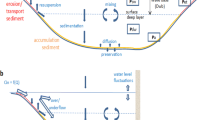Abstract
Monitoring data collected from the Mingder Reservoir in Taiwan indicate that the water quality is between mesotrophic and eutrophic. Chlorophyll a concentration is higher in the summer and anoxic conditions occur in the bottom. The data also reveal that a pronounced vertical thermal gradient in summer and vertical mixing the end of fall. A vertical two-dimensional, laterally averaged hydrodynamic and water quality model (CE-QUAL-W2) was adopted to simulate the water surface elevation, water temperature, and water quality conditions in the water column. The modeling effort was supported with monitoring data collected in the field for a 2-year period in the reservoir. The hydrodynamic model reproduced the time series water surface elevation. Spatial and temporal distributions of temperature in the water column of the reservoir were also well reproduced by the hydrodynamic model. Model-calculated concentrations of key water quality constituents such as nutrients, dissolved oxygen, and algal biomass matched the measured values closely in the reservoir. The calibrated model was then applied to simulate water quality response to various nutrient reduction scenarios. Results of the model scenario runs reveal that a 20% and 80% reduction of the phosphorus loads will improve the water quality from eutrophic to mesotrophic and oligotrophic conditions, respectively. The modeling effort has yielded valuable information that can be used by decision makers for the evaluation of different management strategies of reducing watershed nutrient loads.
Similar content being viewed by others

References
Bai, S., & Lung, W. S. (2005). Numerical modeling of algae in the Patuxent estuary. International Journal of River Basin Management, 3(4), 273–281.
Bartholow, J., Hanna, R. B., Saito, L., Lieberman, D., & Horn, M. (2001). Simulated limnological effects of the Shasta Lake temperature control device. Environmental Management, 27(4), 609–626. doi:10.1007/s0026702324.
Bowen, J. D., & Hieronymus, J. W. (2003). A CE-QUAL-W2 model of Neuse estuary for total maximum daily load development. Journal of Water Resources Planning and Management, 129(4), 283–294. doi:10.1061/(ASCE)0733-9496(2003)129:4(283).
Bowie, G. L., Mills, W. B., Porcellam, D. B., Campbell, C. L., Pagenkopf, J. R., Rupp, G. L., et al. (1985). Rates, constants and kinetics formulations in surface water quality modeling (2nd ed.). Athens, GA: US Environmental Protection Agency, Environmental Research Laboratory.
Carlson, R. E. (1977). A trophic state index for lakes. Limnology and Oceanography, 22(2), 361–369.
Cheng, K. S., & Lei, T. C. (2001). Reservoir tropic state evaluation using Landsat TM images. Journal of the American Water Resources Association, 37(5), 1321–1334. doi:10.1111/j.1752-1688.2001.tb03642.x.
Chou, W. S., Lee, T. C., Lin, J. Y., & Yu, S. L. (2007). Phosphorus load reduction goals for Feitsui Reservoir watershed, Taiwan. Environmental Monitoring and Assessment, 131, 395–408. doi:10.1007/s10661-006-9485-1.
Cole, T. M., & Buchak, E. (1995). CE-QUAL-W2: A two-dimensional, laterally averaged, hydrodynamics and water quality model, version 2.0. US Army Engineers Waterways Experiment Station, Tech. Report EL-95-May 1995, Vicksburg, MS.
Cole, T. M., & Wells, S. A. (2000). Hydrodynamic modeling with application to CE-QUAL-W2. Workshop Notes, Portland State University, Portland, OR.
Kim, Y. H., & Kim, B. C. (2006). Application of a 2-simensional water quality model (CE-QUAL-W2) to the turbidity interflow in a deep Reservoir (Lake Soyang, Korea). Lake and Reservoir Management, 22(3), 213–222.
Kuo, J. T., Liu, W. C., Lin, R. T., Lung, W. S., Yang, M. D., Yang, C. P., et al. (2003). Water quality modeling for the Feitsui Reservoir in northern Taiwan. Journal of the American Water Resources Association, 39(3), 671–687. doi:10.1111/j.1752-1688.2003.tb03684.x.
Kuo, J. T., Hsieh, M. H., Liu, W. C., Lung, W. S., & Chen, H. C. (2006). Linking watershed and receiving water models for eutrophication analysis of Tseng-Wen Reservoir, Taiwan. International Journal of River Basin Management, 4(1), 39–47.
Kurup, R. G., Hamilton, D. P., & Phillips, R. L. (2000). Comparison of two-dimensional, laterally averaged hydrodynamic model application to the Swan River Estuary. Mathematics and Computers in Simulation, 51, 627–638. doi:10.1016/S0378-4754(99)00146-9.
Lung, W. S. (2001). Water quality modeling for wasteload allocations and TMDLs. New York: Wiley.
Lung, W. S., & Nice, A. J. (2007). Eutrophication model for the Patuxent estuary: Advances in predictive capabilities. Journal of Environmental Engineering, 133(9), 917–930. doi:10.1061/(ASCE)0733-9372(2007)133:9(917).
Na, E. H., & Park, S. S. (2006). A hydrodynamic and water quality modeling study of spatial and temporal patterns of phytoplankton growth in a stratified lake with buoyant incoming flow. Ecological Modelling, 199, 298–314. doi:10.1016/j.ecolmodel.2006.05.008.
Naithani, J., Darchambeau, F., Deleersnijder, E., Descy, J. P., & Wolanski, E. (2006). Study of the nutrient and plankton dynamics in Lake Tanganuika using a reduced-gravity model. Ecological Modelling, 200, 225–233. doi:10.1016/j.ecolmodel.2006.07.035.
Suh, S. W., Kim, J. H., Hwang, I. T., & Lee, H. K. (2004). Water quality simulation on an artificial estuarine lake Shiwhaho, Korea. Journal of Marine Systems, 45, 143–158. doi:10.1016/j.jmarsys.2003.11.002.
Trolle, D., Skovgarrd, H., & Jeppesen, E. (2008). The water framework directive: Setting the phosphorus loading target for a deep lake in Denmark using the 1D lake ecosystem model DYRESM-CAEDYM. Ecological Modelling, 219, 138–152.
Wang, X., & Yang, W. (2008). Modelling potential impacts of coalbed methane development on stream water quality in an American watershed. Hydrological Processes, 22, 87–103. doi:10.1002/hyp.6647.
Williams, N. T. (2007). Modeling dissolved oxygen in Lake Powell using CE-QUAL-W2. Master thesis, Brighman Young University, USA.
Wu, R. S., Liu, W. C., & Hsieh, W. H. (2004). Eutrophicaiton modeling in Shihmen Reservoir, Taiwan. Journal of Environmental Science and Health. Part A, 39(6), 1455–1477.
Wu, T. T., Chen, H. C., Kuo, J. T., & Wu, S. C. (2006). Project of eutrophication control for reservoir water quality by ecological engineering. Taiwan: Technical Report to EPA (in Chinese).
Yu, S. L., & Zhen, J. X. (2001). Development of a best management practice (BMP) placement strategy at the watershed scale. In Proceedings of the third international conference on watershed management, Taipei, Taiwan, pp. 59–72.
Author information
Authors and Affiliations
Corresponding author
Rights and permissions
About this article
Cite this article
Liu, WC., Chen, WB. & Kimura, N. Impact of phosphorus load reduction on water quality in a stratified reservoir-eutrophication modeling study. Environ Monit Assess 159, 393–406 (2009). https://doi.org/10.1007/s10661-008-0637-3
Received:
Accepted:
Published:
Issue Date:
DOI: https://doi.org/10.1007/s10661-008-0637-3



